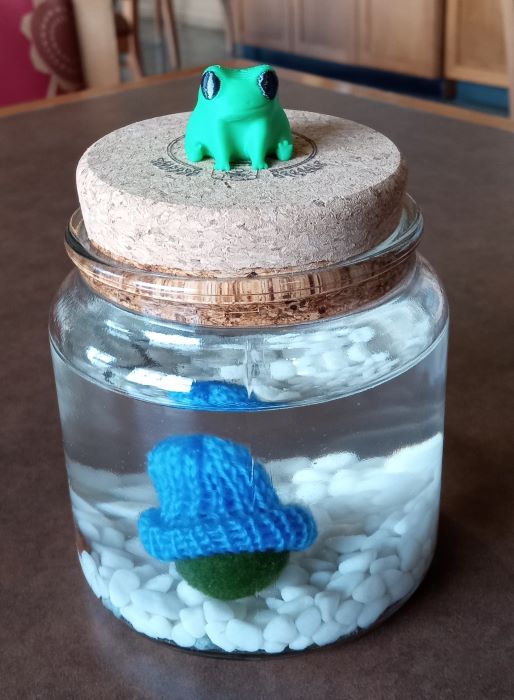Giving a 3D printed frog critter -and- plant buddy to BFF Barb.
Magical Companion story … Al Green / Merlin and Max


I went to the Toyota dealership, a garage relatively close to home, to get air in my tires. While there, just thought I would inquire about the trade-in value of my Subaru. There in front of the window sat a green Toyota Corolla. Tried for a green car EVERY time I purchased one during my nearly 8 decades on this Earth Walk. Had several colors, but no green. The trade-in value was higher than I expected, and there sat the green car right in front of the window. Yep, finally have a green car as I enjoy the last season of my life.
While signing the mound of paperwork, there sitting on Keerstyn’s desk was another moss buddy. We had a delightful chat sharing adventures.
So, today gifted me with several surprises.
NAME
The common name, marimo, is Japanese for “seaweed balls.” The little green spheres are not actually moss, but algae. In their natural habitat, the algae balls live at the bottom of cold lakes. They keep their round shape by the action of the waves.
Marimo (also known as Cladophora ball, moss ball, moss ball pet, or lake ball) is a rare growth form of Aegagropila linnaei (a species of filamentous green algae) in which the algae grow into large green balls with a velvety appearance.
LIGHT
The good news is, marimo balls do not need a lot of light to thrive. “They don’t need to be in bright sun since they naturally grow at the bottom of the lakes,” says Steinkopf. “They prefer a lower light situation.” The algae do not like direct sun and should not be placed near a window, as marimo can quickly turn brown if they are getting too much direct light. Keeping them out of direct sunlight and giving them plenty of low, indirect light should keep them happy.
WATER
Moss balls are aquatic plants, so they must live submerged in cool water, preferably under 77°F. These plants aren’t too picky about the type of water; it just has to be freshwater. “I use my tap water, but well water, distilled water, or rainwater would be fine as well,” says Steinkopf. For best results, change the water every two weeks and allow the water to sit out for a day beforehand, so chlorine has a chance to evaporate. Also, clean the container with a brush if algae start to grow on the surface.
FERTILIZER
Marimo does not require supplemental fertilizer! These amazing plants make their food through photosynthesis and do not need a nutrient boost to keep them thriving. They are slow-growing, so don’t expect them to outgrow their tanks within a year. The plants grow up to 5 millimeters per year and will eventually reach 2 to 5 inches in containers or 8 to 12 inches in natural conditions.
COMMON PROBLEMS
Besides turning brown from too much or insufficient light, some marimo moss balls will occasionally float or lose their round shape. Floating occurs due to trapped air bubbles in the plant. To get them to sink again, give them a gentle squeeze to pop the air bubble. The marimo will sink to the bottom of the tank within a couple of days. Marimo can lose their round shape due to a lack of agitation in the water. Remember, it’s the wave motion that keeps them round in their natural habitat. “They need to be swirled around in the bowl they are in to mimic that environment and keep them round,” says Steinkopf. “It also helps them get light around the ball. If one side doesn’t ever get any light, it will turn brown.”
PROPAGATION
Marimo balls are easy to propagate. “Pieces of them can be pulled off to make new ones,” says Steinkopf. Cut the ball in half and shape it into a ball. You may need to use twine to hold the shape of the ball until it’s established. Place it in the bowl of water, and turn it at least once a week to encourage growth all around.